The peril of "normal" Christmas activities in space
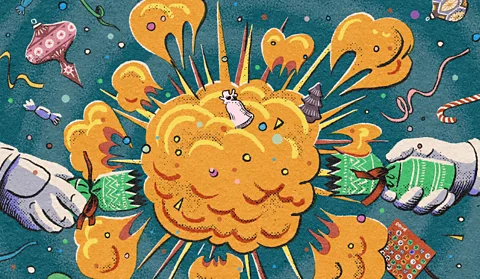 Emmanuel Lafont/ BBC
Emmanuel Lafont/ BBCRaw turkey, rogue baubles and pine needles, everywhere – here's how not to have a traditional Christmas in space.
It's 6.30 in the morning on Christmas Day. With a flutter of excitement, you unstick your eyelids and squint out into the lingering winter darkness – except it's not dark at all. The room is lit as brightly as a dentist's office, and some people seem to be, er, sleeping the wrong way up. You go to roll out of bed… and find you're strapped in. OK, this is getting weird. And where are all your presents??
In fact, through some unlikely cosmic accident (probably something to do with quantum entanglement) you've woken up on the International Space Station (ISS), rather than your own bed. In this household, night-time darkness only lasts 45 minutes – and if you weren't strapped in, you'd have done an endless zero-gravity roly-poly.
It looks like you're spending Christmas Day in space. And you're determined to do it properly – makeshift paper decorations and rehydrated, space agency-approved meal pouches just won't cut it.
So, what would really happen if you tried to have a completely "normal" Christmas aboard the ISS – one with exploding crackers, gaudy tinsel and an unwholesome quantity of Christmas pudding? And how do astronauts celebrate it in reality? From run-away champagne to turkey cooked in a "briefcase", welcome to the sheer chaos of a festive gathering while in orbit.
Christmas trees
By Zaria Gorvett
First up, the ritual of Christmas preparations wouldn't be complete without taking a perfectly happy tree and dragging it indoors. And as atomic luck would have it, one has accompanied you as you were teleported into the ISS.
The problems start almost immediately. It's a real live tree, of course – you're aware of the absurdity and decadent carbon footprint of plastic foliage – but as you stuff it into its festive pot, the soil just keeps floating back out again in little bits. Surrounded by a cloud of soil "asteroids", and trying not to get any up your nose, you turn to the watering can – surely this will help? As the liquid emerges, it mixes with the soil bits and you end up with a large, muddy blob. It floats off and attaches itself to the ceiling.
Next come the decorations. The tree must have been in space for some time, because its needles have reversed. As one Nasa experiment discovered, pine trees get confused in a zero-gravity environment – and rather than pointing downwards, as is usual, their needles start to angle upwards like hairs on the back of an angry cat. Luckily it doesn't matter which way up they are, because technically there is no up or down on the ISS anyway.
Unperturbed, you press on and add some baubles. They hang at unusual angles – some are upside down, while others point sideways. The final flourish is a string of tinsel, which immediately disintegrates just as it would on Earth, leaving tiny bits sailing across the room and, rather ominously, making their way towards the air filters. You take a step back (or really, a clumsy weightless glide) and survey your work. Sure, the tree looks a bit haphazard – it's wonky, because it doesn't know which way is up – but the space station looks more Christmassy already.
There have been Christmas trees in space before, of course. The first was made by the Skylab 4 astronauts Gerald Carr, William Pogue and Edward Gibson in 1973, who improvised a festive centrepiece from leftover food containers. In one ghostly black-and-white photo, it looks surprisingly good, a bit like a plastic tree that's covered in fake snow. Rather appropriately, the team topped it with a cardboard cut-out in the shape of a comet.
"One of the things that makes it probably impractical [to have a real tree] is just keeping it alive," says Mike Hopkins, a Nasa astronaut who has spent Christmas on the ISS twice and returned from a mission earlier this year. "Because a lot of times when you have a supply vehicle that comes up you need everything that's going inside of it sometimes months in advance – and then you close it up." So, your tree would not only be eccentric, but half-dead.
To overcome these challenges, you might want to try asking any real astronauts onboard for some tips (and hope they're not annoyed that you've taken over their Christmas). For example, experimental plants on the ISS are usually provided with a powerful light above them, so they can photosynthesise and have some idea of which way is up – this will have has the added benefit of illuminating your festive masterpiece nicely. And ideally you'd abandon the fancy Christmas pot, though it is lovely, and embed the tree's roots in a special pillow-like device, which stops them from being waterlogged – unlike on Earth, water won't trickle down to leave drier soil at the surface.
But alas, even once your tree is up in all its dishevelled glory, the difficulties of an extra-terrestrial Christmas are far from over. BBC Future investigates the snags and stumbling blocks you're likely to encounter as you plan your perfect festive day at 1,309,000 feet (248 miles or 400km).
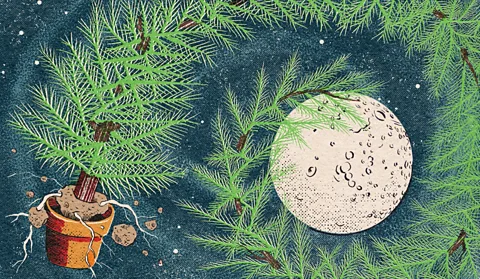 Emmanuel Lafont/ BBC
Emmanuel Lafont/ BBCChampagne
By Harriet Constable
Undefeated by your unconventional-looking tree, you remain determined to keep in a festive mood. Your next thought is, of course, "I could really go for a glass of bubbly right now."
Well firstly – no. You can't have one. Astronauts are widely prohibited from drinking any alcohol while in space. Shame on you for even thinking of it.
But then again you have just been teleported here, and have no astronaut duties. Or what if you opted for an alcohol-free alternative to champagne? Like lemonade. Surely a glass of lemonade would be OK?
Well it's bad news again folks because, according to Nasa, bubbles don't do well in space. "A foamy mess" – that's how they describe trying to drink carbonated drinks, from champagne to cola, while the station races around the Earth. "The bubbles of carbon dioxide in carbonated beverages aren't buoyant in a weightless environment, so they remain randomly distributed throughout the fluid, even after swallowing," says Nasa. The whole thing is actually rather unpleasant, especially given the fact that, with the absence of gravity, the carbon dioxide bubbles in the drinks go through the digestive system, rather than being burped out as on Earth.
Even if you were allowed a glass of champagne, there's the whole issue of actually getting it out of the bottle because, as Wired reports, "you cannot pour a liquid in zero-g". One option is to drink it through a straw, but as I write this, I believe Dom Pérignon, a French monk who helped pave the way for sparkling champagne to become mainstream, just rolled over in his grave.
It might not always be this way. Companies are at work to pop the bubble-in-space issue in as we speak – with solutions including twin-chambered bottles. But for now you’ll have to return to your weightless wandering without a festive glass of fizz.
Gifts
By Richard Gray
Most of us probably know someone whose gifts look as if they might have been wrapped while in orbit. Without the tether of gravity, all but the tautest wrapping paper will bob shapelessly around the present inside, while lengths of sticky tape will flap into an unruly tangle once torn from the roll.
Nasa has some strict rules about how many personal items astronauts are allowed to carry with them into space. Crews are usually limited to just 3.3 lbs (1.5kg) of personal kit when they travel to the ISS, but they sometimes get additional items in re-supply missions.
Launching anything into orbit is expensive though – until recently it cost around $18,500 (£13,900) per kg (and when the space shuttle was operational the cost was $54,500 [£41,000] per kg). More recently Nasa has been able to use commercial spacecraft such as Space X's Falcon 9 and Dragon capsule, which allows items to be launched at a cost of $23,330 (£17,500) per kg, but the amount of space available for gifts among the research experiments and hardware sent to the ISS is small. Nevertheless, Nasa tries to squeeze in a special delivery shortly before Christmas.
"A lot of times it has to be something small," says Hopkins. "So it'll be just a card, something of that nature. But folks here on the ground, support personnel, also do a great job reaching out to your family members and trying to find ways to get some special things up to you for the holidays."
But in your chance teleportation, you and all your festive paraphernalia managed to get to the station with little to no budget at all. So how will your wrapping go?
Surprisingly there isn't much research on the mechanics of gift wrapping in microgravity. (Although Nasa engineers use origami techniques when designing the folding solar arrays and shields on spacecraft.) Nasa prefers plastic bags and white fabric duffle bags for any of the goods it transports to and from the ISS.
Although the natural stiffness of paper might mean it will remain in the shape when folded, without gravity keeping the gift and paper together in the early stages of wrapping there might be an extra dimension of difficulty. If what happens to a cloth when it is crumpled on the space station is anything to go by, folded paper won't behave exactly as it does on Earth either.
Sticky tape – which is widely used on the space station to hold things down, perform quick fixes and even seal air leaks – also wafts around, as in this video with Nasa flight engineer Cady Coleman, and curls strangely without the tug of gravity. Until recently, ISS crew usually kept their rolls of tape in place by sticking them to surfaces inside the space station. In 2021, however, they received a new tape dispenser specially designed for use on the ISS that can be used one-handed and would doubtless make wrapping any gifts easier.
Fortunately, according to some studies, a poorly wrapped gift isn't anything to worry about – it might actually make the recipient all the more grateful for what is inside.
Roast dinners
By Isabelle Gerretsen
After all your hard work with the tree and oddly shaped presents now strapped around its base, you have worked up quite an appetite. But, if past Christmases on the ISS are anything to go by, a traditional dinner is unlikely to look like anything you're used to on Earth.
Elaborate dinners in space are a bit of a challenge, to say the least, but that doesn't stop astronauts from celebrating during special holidays. Hopkins has spent two Christmases on the ISS and says both times the food was "excellent".
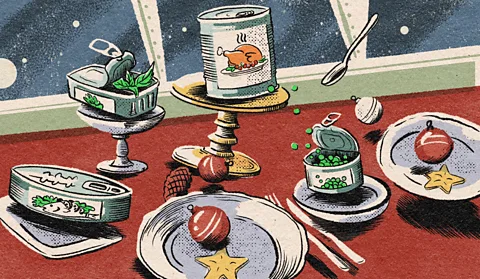 Emmanuel Lafont/ BBC
Emmanuel Lafont/ BBCFor Thanksgiving and Christmas, typically American food is served. Turkey, sweet potatoes and green beans are all staples on board the ISS. No alcohol is served on the station because it risks damaging equipment and could impair astronauts' judgement as they travel through a near vacuum at nearly 17,200 mph (27,700km/h).
Salt and pepper is on offer to season astronauts' food, but only in liquid form as the tiny granules would float away and could clog air vents or get stuck in people's eyes and noses.
It's impossible to prepare a full roast dinner on the ISS. All the food is brought up to the station in small plastic pouches where it is heated in the "food warmer" – a cross between a toaster and an oven which resembles a briefcase. It takes around 20 to 30 minutes to recreate and heat a meal in space.
Mixing sauces and gravy into food is a big challenge, says Hopkins. "It's really hard to take stuff out of one package and add it to the other [food]." Some astronauts choose to put all the ingredients into a "mixing bag", sealing it tightly before mashing it with their hands.
Setting the dinner table is another conundrum. To stop dishes from flying around the station, the food is stuck to the table with duct tape, cords and Velcro. "It's not quite as good for the photos as the [Christmas spreads] with all the food laid out," says Hopkins.
Space travel can affect astronauts' sense of taste and smell. On Earth, bodily fluids are pulled down into our legs. Without gravity, the fluids are distributed throughout the body, including in our face. This creates a similar feeling to a bad head cold or blocked sinuses and leaves food tasting bland. Astronauts often ask for hot sauce and other condiments to add some intensity of flavour to their food.
After eating packaged food for months at a time, astronauts are craving some freshly cooked meals when they get back to Earth.
"A lot of our holiday meals were cooked years in advance, so by the time they end up on the station, they've been kept in storage for a while," says Hopkins. "One of the things I really missed [in space] is food that's freshly prepared and goes right from the kitchen onto your plate."
Christmas crackers
By Zaria Gorvett
Of course, there's one essential element of Christmas dinner that can't be eaten – Christmas crackers.
So, when you finally corral the other guests to sit down at the table (or, rather, strap themselves into the dining chairs on the ISS), you start by pulling yours – and it's instant chaos. You're relieved to be strapped in, because otherwise you'd have ended up colliding awkwardly with your cracker partner. In space, the lack of gravity means Newton's third law of motion becomes a lot more visible – namely, the fact that if you exert a force on an object (like a cracker), it exerts an equal force right back at you.
You also notice that the tacky gifts, which are notoriously hard to find anyway, have travelled significantly further than usual – soon there are tiny packets of playing cards and novelty keyrings all over the space station.
And there is a much bigger problem. These glorified cardboard tubes may seem innocuous, but they are made with actual gunpowder – it's usually hidden in the strips of paper found in the centre of the tube. Rather than being ignited via a long fuse, like medieval cannons were, this concoction of charcoal, potassium nitrate and sulphur explodes due to the friction generated as the cracker is pulled apart.
You're particularly unlucky this Christmas, so you find that you have accidentally started a fire. And it is unlike any you've ever seen before.
Back on Earth, fires rely on convection to keep burning. As the fire heats the air around it, it becomes excitable and travels upwards – and at the same time, cooler, denser air moves in below to fill the gap. This has two major effects. Firstly, the rising column of air creates the characteristic teardrop shape of a flame, and secondly, it keeps the fire going, because fresh, unburned air is continually being resupplied.
But in space, this doesn't happen. There is no gravity to keep cool air down, so it spreads evenly around, creating a truly alien sight: a blue spherical flame. And where the fire would normally spread upwards, following the trajectory of its hot flames, in space it can spread in any direction – so the fire follows the path of the fans on the ISS that help to circulate fresh air.
"Trying to get them through the safety office here, to say, 'I want to take up some Christmas crackers' – I would love to sit in on some of those meetings," says Hopkins.
(Luckily, there are professional astronauts onboard who are well trained in fire safety protocols, so the fire is brought under control and Christmas is saved. Hooray!)
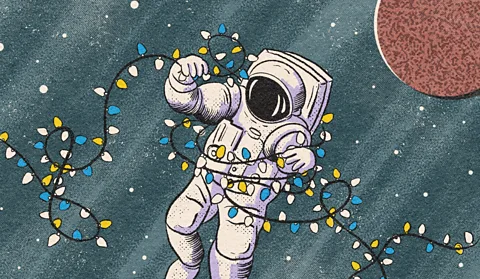 Emmanuel Lafont/ BBC
Emmanuel Lafont/ BBCChristmas pudding
By Stephen Dowling
Before Briton Tim Peake blasted off into space in December 2015, he said he was looking forward to a few things while in orbit in the ISS. One was a spacewalk, which would make him the first Briton to do so. Another was Christmas pudding for his festive lunch 250 miles (400km) above the Earth.
Peake did indeed conduct a spacewalk, and he also tucked into a portion of the traditional Christmas dessert as well. But it was not something rustled up within the confines of the space station. Physics along with health and safety meant the pudding was packed alongside other comestibles and sent up in an unmanned supply ship a few weeks before the big day.
Pudding traditionalists will, of course, point out that puddings made weeks or even some months ahead of Christmas have a better flavour. But this pre-production had little to do with the taste test and more to do with the challenges of cooking something in orbit.
Harsh Patel, a science interpreter and presenter at the UK Space Centre, says baking any traditional cake in space creates one big problem – crumbs. Any crumb is a potential danger as it floats across the interior and finds its way into instruments.
Traditional puddings, then, are a no-no. Like any baked good consumed on the ISS – even the bacon sandwich which greeted Peake when he first entered the space station – the pudding is covered in a gluten layer which prevents crumbing.
Baking in space presents other challenges too. The lack of gravity means no convection, required for even, consistent cooking. A Zero G oven – using radiating heat like a toaster – has gone up into space, Patel says, and has already been used for cooking experiments in 2020.
"They baked five cookies and three of them were sent back to Earth right away so they could be used in experiments," says Patel. The five cookies had taken 75 minutes to cook instead of the 20 needed on Earth, and after that marathon baking session, the chefs were not allowed even a nibble.
Singing
By Richard Gray
With dinner over, and the astronauts cruising towards an afternoon snooze, you think it's about time for a few carols to rouse energy levels. But as you attempt a vigorous rendition of O Come All Ye Faithful, you realise you don't sound anything like yourself.
Looking to past choral forays on the ISS, it's easy to see why.
With eyes squeezed half shut and the blue haze of Earth’s atmosphere drifting behind him, veins throbbed in Canadian astronaut Chris Hadfield's neck and forehead as he hit the higher notes of David Bowie’s Space Oddity when he recorded this now famous rendition of the song onboard the ISS.
But singing while in space is difficult, Hadfield told Canada’s CBC Music. Without gravity to drain the blood and fluid out of his head and sinuses, his airways and vocal cords swelled up, changing the register of his voice. Compare his in-orbit rendition to later ones he recorded after returning from space, and it is possible to hear what happened to him (although it is worth remembering the professional recording equipment available to him on Earth will have been far superior to anything on the ISS).
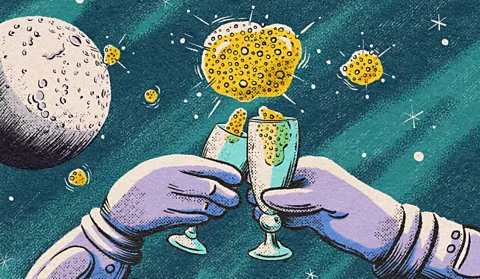 Emmanuel Lafont/ BBC
Emmanuel Lafont/ BBC"Your head gets kind of fat and your sinuses fill up, your tongue gets swollen, your vocal cords are swollen and you're that way for six months," says Hadfield. "So it's a terrible place to sing because it's like singing with a head cold the whole time."
He likens the experience to singing while standing on your head for three hours.
:"You don't get that resonance out of your voice as it echoes through your sinuses and the range of your vocal cords is a little higher. It kind of changes the register of what you're capable of."
Analysis of recordings of the Apollo 11 astronauts while on their mission also indicate their voices changed in frequency and the spectrum of sound produced by their vocal tracts shifted. The researchers at the University of Texas at Dallas who conducted the study say there could be a number of changes in atmospheric conditions, gravity, as well as perhaps just simple excitement, which could be responsible for these changes.
While not much of a problem for non-musicians who might want to hit the extremes of their vocal talents, the researchers warn it could have some implications for voice recognition technology should it be deployed on spacecraft in the future.
For Hadfield, the changes to his voice while in orbit made covering Bowie's songs easier because of the higher notes, but he says deeper notes were harder.
Snow
By William Park
As the day wears on, the idea to go for a snowy afternoon walk in the crisp Christmas air occurs to you. Of course, there's not normally any snow on the ISS. So, other than going back to Earth, where else could you go?
Hurtling through space, you consider the ice-giants of Uranus and Neptune, where temperatures drop to -200C (-328F) and winds on the latter can reach 1,300mph (2,092kmph). These planets are perhaps the most extreme otherworldly winter wonderland you can get. But there are drawbacks. Both planets have clouds of atmospheric methane or ammonia ice crystals that swirl around in strong winds. A trip to either planet would certainly give you a chill, but they are probably not the best places to build a snowman.
If you would like to see water-based snow in space, you will need to travel a little further afield – about 880 light years from Earth. The only place we have observed space snow to date is around the star V883 Orionis.
Young stars like V883 Orionis are often surrounded by rings of gas and dust. Around 450 million km (280 million miles) from the star is the water-snow line – a point at which gaseous H2O freezes, skipping the liquid state. This line is important because it dictates the kinds of planets that form around a star. Within the water-snow line, where H2O is a gas, rocky planets like Earth form. In the icy rings beyond the water-snow line, ice gathers together into giant space snowballs which give rise to gas- and ice-giants like Saturn, Uranus and Neptune.
In 2016, researchers using the Atacama Large Millimeter Array (Alma) in Chile were the first to observe the water-snow line around V883 Orionis. They were able to do so because the star is unusual. An increase in its brightness has pushed the snow line out to six billion km (3.7 billion miles) – or the equivalent distance from our Sun to dwarf planet Pluto – making it easier to spot from so far away.
"On Earth, lower temperatures generally mean [that snow forms] simpler snow crystal shapes rather than the intricate, many-branched ones," says Jussi Leinonen, a researcher at the Federal Office of Meteorology and Climatology, Switzerland. The temperature at the water-snow line around V883 Orionis is about -140C (-220F). This is much colder than it ever gets on Earth, where temperatures have dipped as low as -98C (-144F). This might mean that ice crystals at the water-snow line are simple, though Leinonen notes that his experience is in Earth snow and he is speculating that the same rules would apply to space snow.
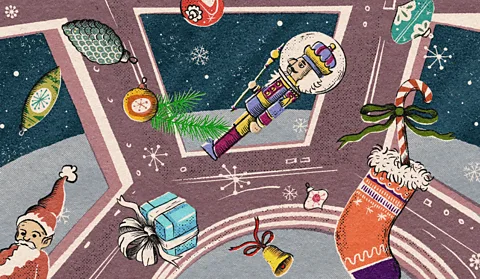 Emmanuel Lafont/ BBC
Emmanuel Lafont/ BBCThe flurries that fall so satisfyingly on Earth might also look different in space. The snow is made up of clumps of ice crystals that gather together high in the atmosphere. As each crystal sticks to another, the snowflake grows, gathering more and more flakes and falling to Earth faster and faster.
"In a microgravity environment, collisions between snowflakes could still occur due to their random motion, but this process would be slower and create more symmetric snowflakes because there would not be a preferred direction for the collisions," says Leinonen. So instead of thick flurries, space snow might float in little flakes glistening in the light of their star.
Gingerbread
By Sophie Hardach
After decorating, gifting, cooking up a feast, singing and at least contemplating a wintry walk, what would your Christmas in space be without filling any corners with a few last delicious delicacies?
Festive treats, including hot chocolate, fruitcake and other nostalgic Christmas dishes, can take on an added significance in space – not just as a source of nourishment, but also as a mental and emotional boost. In fact, tasty food is thought to be so critical to the success of missions that astronauts are allowed to choose about 20% of their fare, in addition to a standard menu.
In reality, "like Earth-bound humans, astronauts require enjoyable foods that the average person would want to consume day after day," wrote Grace Douglas, lead scientist for Nasa's Advanced Food Technology at the Johnson Space Center, and others in an article on nutrition in space.
When Nasa tested giving astronauts energy bars instead of their standard breakfast, they ate less, lost weight, and had worse moods. The bars' flavour, texture, and the astronaut's "menu fatigue" – that is, getting bored of eating bars – were all thought to be contributing factors to that downward slide.
Early Christmas space food similarly missed the mark: the gingerbread squares sent with the Apollo 17 moon-landing mission in December 1972 weren't to those astronauts' tastes, and went back to Earth uneaten.
The ISS crew's choices for their Christmas meals highlight the emotional power of festive flavours in particular, with astronauts typically picking dishes from their childhoods.
European Space Agency astronaut Thomas Pesquet had a French chef prepare a feast of nostalgic Christmas dishes from his childhood in France, to share with his crew onboard the ISS in 2016. It included tinned gingerbread. "I used to love [gingerbread] when I grew up, when I was a kid," he says in a video message. "So that was one of my wishes, was to have gingerbread on board the space station."
As with so much about festive celebrations, it's not just what you have but what it means to you. As such, despite misshapen decorations, a glutinous dinner and almost setting the ISS on fire, BBC Future concludes that – with enough goodwill – it is indeed still possible to have a very merry Christmas in space.
--
